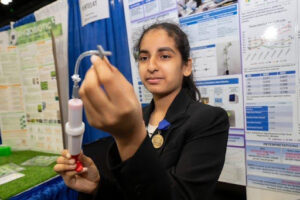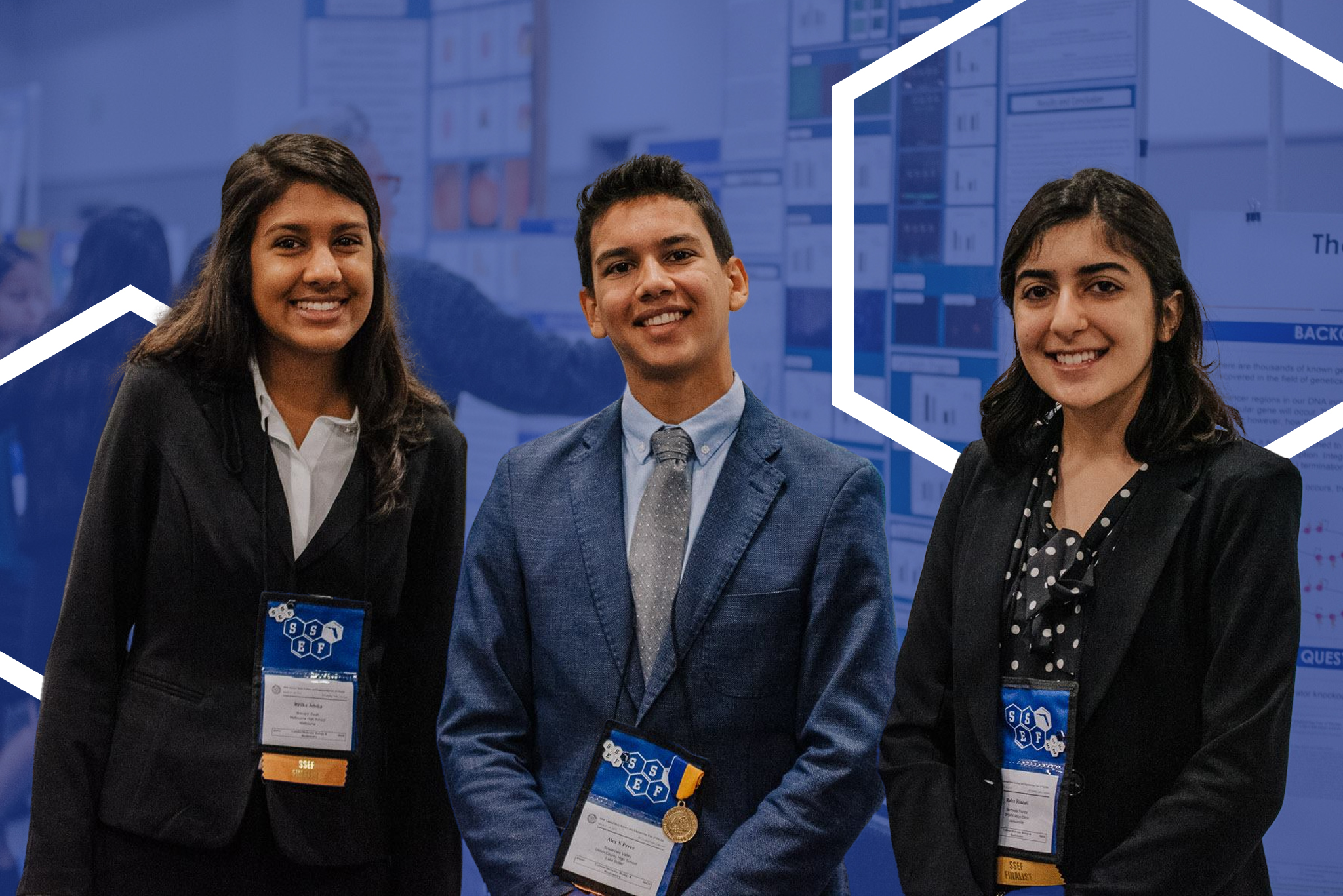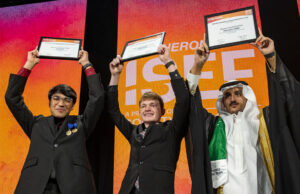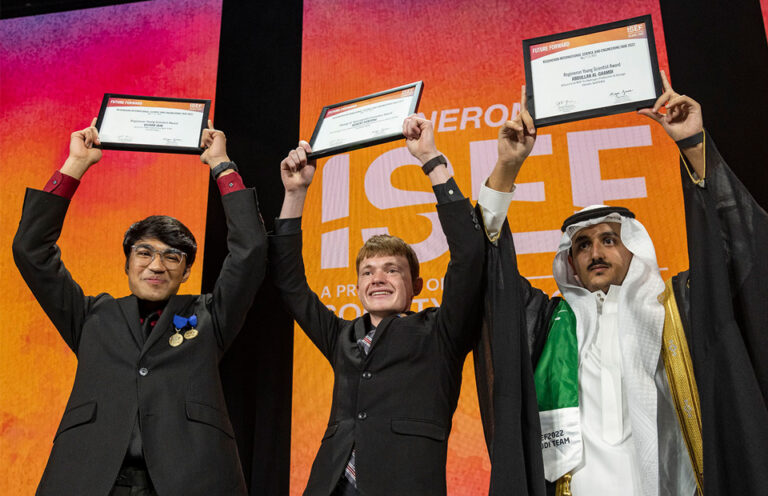WASHINGTON, DC – Sept. 18, 2018– Broadcom Foundation and Society for Science & the Public today announced the 30 finalists in the 8th annual Broadcom MASTERS®, the nation’s premier Science, Technology, Engineering and Mathematics (STEM) middle school competition.
The finalists will travel to Washington, DC from October 19-23 where they will participate in a rigorous competition that leverages Project-based Learning to test and demonstrate their mastery of 21st Century skills of critical thinking, communication, creativity and collaboration in each of the STEM areas.
Broadcom MASTERS (Math, Applied Science, Technology and Engineering for Rising Stars), a program founded and produced by the Society for Science & the Public, seeks to inspire young scientists, engineers and innovators who will solve the grand challenges of the future. In addition to participating in team challenges, the finalists will meet with government officials and showcase their projects for the public during a free event at the National Geographic Society on October 20 from 1-4pm. Winners will be named during an awards ceremony on October 23 at the Carnegie Institution for Science.
“Congratulations to the 2018 Broadcom MASTERS Finalists – and to every young scientist, engineer and mathematician who has competed in state and regional science fairs this year,” said Paula Golden, President of the Broadcom Foundation. “It is exciting to see so many young people showing their passion for STEM subjects early through competitions like the Broadcom MASTERS. By cultivating their STEM talents in middle school, students will continue in STEM fields in high school and college and become the scientists, engineers and innovators of the future.”
“Science competitions like the Broadcom MASTERS are critical to the STEM talent pipeline,” said Maya Ajmera, President & CEO of the Society for Science & the Public and Publisher of Science News. “I applaud all the impressive young people who have been named finalists.”
2018 Broadcom MASTERS Fast Facts:
- Nearly the same number of female (14) and male (16) students
- Students from 28 schools, across 14 states
- Most populous states: nine from California, four from Florida, three from Oregon and Georgia, two from Kentucky
- States with one finalist: Arizona, Illinois, Iowa, Massachusetts, Missouri, New York, Pennsylvania, Texas and Utah
- Finalists were selected by a panel of distinguished scientists and engineers from a record number of 2,537 applicants in 35 states.
- Finalist projects cover multiple disciplines of science, including environmental and earth science, medicine and health science, electrical and mechanical engineering, microbiology, biochemistry, bioengineering, computer science, software engineering, behavioral and social sciences, energy and sustainability, animal science, chemistry and plant science.
- Finalists’ independent research projects include a range of topics such as
- Effect of radiation on bacteria
- Using radio frequency identification technology for school safety
- Designing a dual axis solar tracker
- Using machine learning to forecast the progression of Alzheimer’s Disease
- Detecting concussions in youth sports
A full list of the finalists can be viewed here:
https://student.societyforscience.org/broadcom-masters-2018-finalists.
The Broadcom MASTERS is the only middle school STEM competition that leverages Society-affiliated science fairs as a crucial component of the STEM talent pipeline. Only the top 10 percent of 6th, 7th, and 8th grade projects entered into Society-affiliated fairs around the country are eligible to apply.
All finalists receive a $500 cash award and an all-expense paid trip to Washington, DC, for the competition, where they will compete for the following awards:
- $25,000 Samueli Foundation Prize, a gift of Susan and Henry Samueli, Co-Founder of Broadcom Corporation, Chairman of the Broadcom Foundation, and Chief Technical Officer of Broadcom Limited, for the student who demonstrates mastery of all STEM fields, and exemplifies how research, innovation and teamwork come together to impact our everyday lives.
- $20,000 Robert Wood Johnson Foundation Award for Health Advancement, which recognizes the student whose work and performance shows the most promise in health-related fields.
- $10,000 Marconi/Samueli Award for Innovation, awarded to a student who demonstrates both vision and promise as an innovator.
- $7,500 Lemelson Award for Invention, awarded by The Lemelson Foundation to a young inventor creating promising solutions to real-world problems.
- First and Second Place Awards issued in each category of STEM of $3,500 or $2,500, respectively, to be used toward a STEM summer camp experience, plus an iPad, with top awards in math from Robert John Floe, President Floe Financial Partners.
- Two Rising Stars in sixth or seventh grade will be named as delegates to represent the U.S. at the 2019 Broadcom MASTERS International next spring in Phoenix. Delegates will attend the Intel International Science and Engineering Fair, the world’s largest international high school science fair.
Broadcom MASTERS recognizes finalists’ science teachers with a one-year classroom subscription to Science News magazine and awards the finalists’ schools with $1,000 each to use toward STEM activities.
JANANI KUMARAN
Abraham Lincoln
Alachua Region Science and Engineering Fair State Science and Engineering Fair of Florida — Ying Scholars
Developing a Device to Predict Autistic Meltdowns Using Arduino & MS Azure
Project Background: Asmi knows a boy whose sister has autism. Autism includes a range of conditions. People with autism often have problems with social skills. Many of also have repetitive behaviors or problems with communication. Although some people with autism can hold jobs and function at a high level, other people have more serious problems. The sister of the boy Asmi knows has serious disabilities. Sometimes the girl and other people with autism have meltdowns. They lose control when they become overwhelmed. Asmi wanted to help. Her device aims to warn people when one of those meltdowns might occur. With a bit of warning, family members and caregivers could perhaps take action to help protect someone.
Tactics and Results: Asmi built and programmed a device that tracks users’ heart rates. As someone wears it on their wrist, the device sends data to a web-based and mobile program. The program calculates the beats per minute. It also calculates additional statistics dealing with the intervals and peaks as the heartbeat rate changes. The program then compares those data to the “normal” heart rate range for each individual user. If the heartbeats begin to increase too rapidly in a short time, or if they
soar or dip abnormally, the program sends out a notification through the mobile app. That warns a parent or caregiver of a potential meltdown. Testing with peers, publicly available data and simulated data showed that the device could accurately detect and predict abnormal heartbeat rates. Asmi hopes to work with university researchers to get more data on autistic children. That way she can keep working to improve her device.
Other Interests: “The music a piano can create is beautiful and so relaxing,” says Asmi. She has been playing for more than eight years. She also enjoys singing in the choir and playing basketball with friends. “It’s a perfect activity for anyone to have fun!” she says. Beyond that, Asmi considers math her “greatest passion.” She often hosts summer math circles at a neighborhood clubhouse. And she tutors other students in her local area. Asmi plans to become a computer scientist.
VARUN MADAN
Lake Highland Preparatory School
Dr. Nelson Ying-Orange County Science Exposition and State Science and Engineering Fair of Florida — Ying Scholars
Field Testing of Feeding Bacterium Bifidobacterium infantis (Found in a Human Gut Probiotic) in Order to Improve Honey Bee Health
Project Background: Honey bees play a huge role as pollinators. They fertilize many of the plants farmers grow, which helps provide us with fruits and vegetables. Seventy years ago the United States had about six million managed beehives. Today fewer than three million remain. The rapid decline needs to stop, Varun says. “Otherwise, our most prized pollinators could go extinct.” A university professor’s talk taught him about immune system problems faced by many bees. Varun wondered whether supplemental feeding of a helpful gut bacterium could help honey bees. He decided to find out — even if it meant a bit of discomfort. “I was stung 42 times, once even in my bellybutton!” he says.
Tactics and Results: Varun used a type of bacteria called Bifidobacterium infantis (B. infantis). It helps keep people’s digestive tracts healthy. Some research suggests it mayalso help with the immune system. Varun fed sugar solutions with high and low doses of the bacteria to bees in two hives each at a local apiary. He fed plain sugar solution to a fifth hive that was his control group. Varun replenished the solutions every two weeks for 6 weeks. Afterward, he collected data from each hive. He counted the eggs and young in five frames from each hive. He weighed each hive’s honey. At set intervals, he tallied bees exiting each
hive to forage, and he calculated totals for the number of bees and brood in each hive. “We clearly had a winner,” Varun reports. “The low dose-fed hives outperformed high dose and sugar solution-fed hives in three of the four study parameters.” In his view, the bacteria have the potential to be an effective tool for enhancing honey bee health.
Other Interests: Varun loves doing theatre. “It has taught me creativity, patience, hard work and dedication throughout many rigorous rehearsals and performances,” he says. He’s also in choir and enjoys Bollywood dance. He plays several instruments too, including the piano, violin, guitar and drums. As an athlete, he’s active in tennis and track. Varun plans to become an environmental engineer. “This job can change the world in such great ways,” he says.
LILLIAN MEFFORD
Surfside Middle School
Florida Three Rivers Regional Science and Engineering Fair
Operation Turtle Grass: Exploring the Relationship Between Turbidity & Thalassia testudinum in St. Andrew Bay & Grand Lagoon
Project Background: “We live on a lagoon near the Gulf of Mexico, and fish is in our diet,” Lillian says. “I chose my seagrass project partly because healthy fish require healthy seagrass.” Studies have shown that the blade width of turtle grass is an indicator of its health. Lillian wondered how the water’s turbidity might affect the turtle grass’s health. Turbidity deals with how cloudy or hazy water is, and soil runoff or other pollution can increase turbidity. Lillian focused on a specific type of turtle grass growing in a bay near her hometown. The bay is an estuary – a transition zone between a river and a marine environment.
Tactics and Results: Lillian collected water samples from four places in St. Andrew Bay in Florida. To measure turbidity, she compared the water’s observed turbidity in vials to calibrated samples. She also described the appearance of the water at each spot. Water from the location with the highest turbidity was “dark and murky,” Lillian notes. “In fact, mud residue formed on my skin when collecting samples there.” That spot was near a bridge and concentrated human development, she adds. Lillian also carefully cut more than 1,900 turtle grass blades from her sampling spots. Back at home, she counted and logged the number of healthy blade samples from each location versus ones that were damaged or dead. She also used a ruler to measure the width of each blade at its base. She recorded all the turtle grass data on a spreadsheet. Then, she compared the average blade widths with the turbidity levels at each location. The more turbid the water was, the lower the average blade width was, Lillian found.
Other Interests: “I love baton twirling because I get very excited and filled with joy when I finally master a trick like the vertical one-turn,” Lillian says. She also enjoys dance, especially lyrical and contemporary styles. She shines on stage too. She recently played Gertrude McFuzz in “Seussical the Musical, Jr.” Her other activities include choir, yearbook and student council. Lillian hopes to become an architect. “Architecture will bring together my love of design, art and color,” she says.
GABRIELA MURIEL
Saint Rose of Lima Catholic School
South Florida Science and Engineering Fair
Paraplegics Achieving Stability in the Vertical Wind Tunnel
Project Background: People who are paraplegics can’t control their legs and lower bodies. Yet many of them still enjoy adventures. Gabriela learned that when she met Jessika and Rey. Both have paraplegia, yet they love assisted skydiving outdoors. “They say they feel free!” Gabriela says. Gabriela enjoys indoor skydiving in a vertical wind tunnel and wanted to help paraplegics to learn that sport as well. However, there was a problem. To “catch the wind,” indoor skydivers need to keep their hips down, arms out in front, and legs bent up behind them. How could paraplegics do that, if they couldn’t control their legs?
Gabriela decided to find a way.
Tactics and Results: Gabriela built models for two devices to keep a paraplegic person’s legs in the proper position for indoor skydiving. One model holds the ankles in place. The other is a right-angle pad for the knees. For the ankle holder’s materials, she used Oodles Monster Jumbo noodle foam and industrial strength Velcro. Those materials would not hurt a person’s skin. Yet they would be strong enough to hold the ankles 30.48 centimeters (12 inches) apart and prevent any flapping. To make the knee pad, Gabriela used computer design software and a 3D printer with plastic “ink.” Next came field testing at an indoor skydiving center. A professional skydiver and Gabriela both tested the models three times inside the wind tunnel. “Finally, two paraplegic individuals tested the models,” she reports. “It was a success!” Gabriela has since been working another issue for on a way to accommodate a paraplegic’s urine catheter better. That wasn’t a problem in the trials. Nonetheless, she says, “I learned from doing my project that ideas are never final.”
Other Interests: In addition to indoor sky diving, Gabriela’s school and community activities include Girl Scouts, art club, and yearbook. Biking, reading and traveling are other favorite pastimes, as well as playing with her dog Amber. “I am interested in nanosystems engineering for a career, Gabriela says. She likes that it has applications in a wide range of fields. For now, she works with computer design software and makes things at a nearby maker lab.





